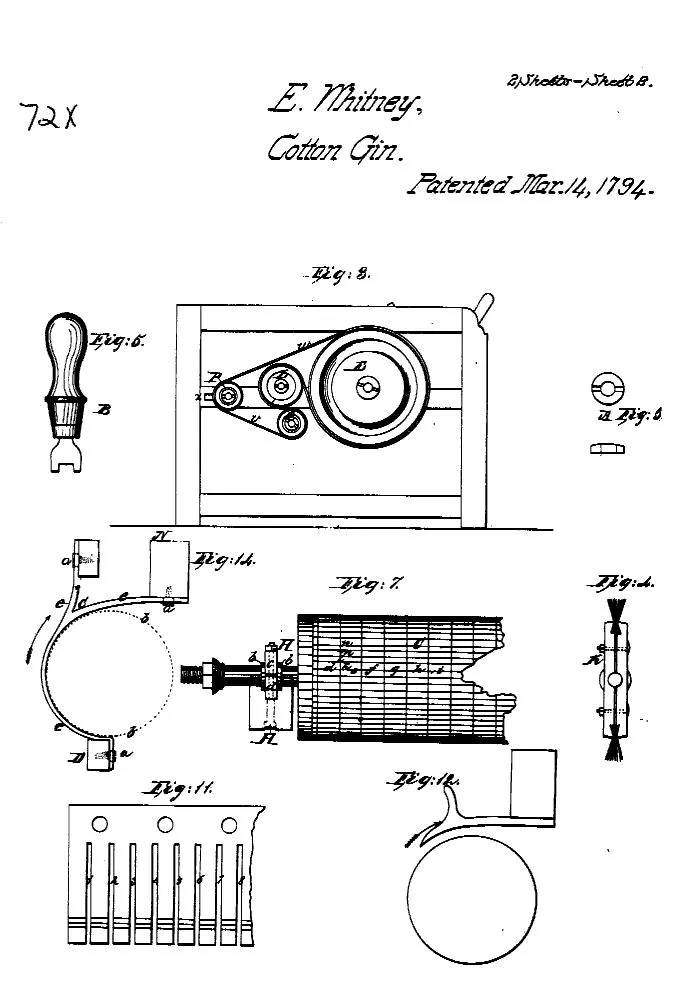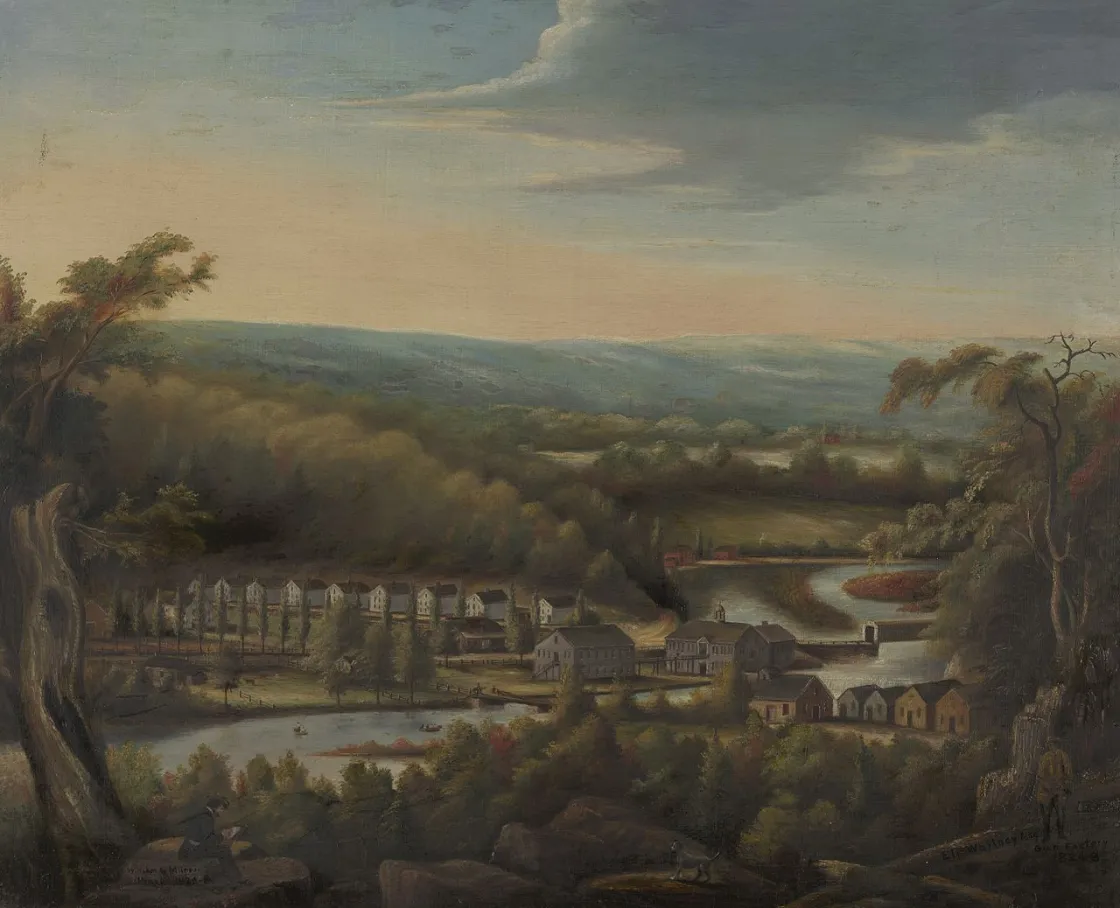Eli Whitney

Eli Whitney was an American inventor and entrepreneur from Connecticut. His most famous invention, the Cotton Gin, made slavery more profitable, prolonging the slave trade and further entrenching the institution in the Antebellum South.
Born in Westborough, Massachusetts on December 8, 1765, into a prosperous New England farming family. In his teenage years, Whitney worked in his father’s workshop, manufacturing nails during the Revolutionary War.
Whitney wanted to attend Yale University, but his stepmother opposed him and refused to pay for his education. Whitney, determined, saved up the money needed, working as a schoolteacher and farm laborer, while also studying to prepare for college. At age 24, Whitney entered Yale in the fall of 1789, as the states debated the ratification of the U.S. Constitution.
He graduated in 1792 and hoped to become a lawyer, a common profession for men with university educations at the time. Due to a lack of money, however, he instead moved south to Georgia, along with many other New Englanders of his day, to seek his fortune. While aboard ship on his way to Georgia, he met Nathanael Greene’s widow, Catharine, who invited him to stay at her plantation, called Mulberry Grove.
While on the plantation Whitney saw first-hand the toil and labor of enslaved people working the cotton fields there. The cotton had to be picked first by hand from the plant, then processed through—again by hand—to remove the seeds or other impurities. The task was laborious and time-consuming. Whitney sympathized with the slaves and wondered if there was something he could do to make the work easier.
Though impossible to confirm, one version of the story goes that Mrs. Greene suggested that Whitney should invent a machine with a filter similar to a brush that would sort the cotton seeds and impurities from the cotton itself. Whitney himself told a different story, claiming that he was inspired when he saw a cat trying to pull a chicken through a fence. Instead of being able to pull the chicken through, only a few feathers came out the other side. In either case, Whitney then drew up a design and created a model of his new cotton gin, which used a mesh of metal wires and a wooden crank to press the cotton through a filter, separating the seeds from the crop.

Whitney hoped that his machine would reduce the work needed to harvest cotton, allowing plantation owners to free the slaves who would otherwise have been tediously picking out seeds from the cotton harvest. He hoped this would hasten the eventual end of slavery in the United States, which many expected to die of natural economic causes.
Eli Whitney was not the first person to invent a cotton gin, nor was he the first American to invent a cotton gin. Other inventors had created versions just years before him. However, Whitney’s cotton gin was much more efficient and effective than the others available.
Whitney applied for a patent in 1793, and his application was approved in 1794. His invention was an immediate success, quickly becoming the predominant tool in the cotton trade. Many farmers illegally reverse-engineered Whitney’s design and made their own so they did not have to buy one of Whitney’s gins. Whitney tried to sue the offending farmers, but loopholes in patent law at the time prevented him from collecting much of the revenue he would have rightfully earned.
On top of his legal troubles, Whitney’s invention rather than helping to bring an end to American slavery and the slave trade, made it slavery more profitable for the enslavers. Whitney invented the cotton gin hoping that less slaves could perform the same work. What plantation owners realized, however, was that the same amount, or even more slaves, would work significantly more efficiently, increasing profits. Tragically, Whitney’s invention almost single-handedly turned the southern slave trade from a declining industry into a booming one, as the American south became one of the world’s top destinations for buying cotton.
Even though Whitney never saw the full potential profits from his cotton gin, the proceeds provided enough to keep him in business as an inventor. Around the same time as he invented the cotton gin, he experimented by creating machines with interchangeable parts. Like with the cotton gin, Whitney was not the first to invent the idea of interchangeable parts. Instead, he promoted and popularized its adoption. He put his methods into practice with his next major venture: producing muskets for the United States Army.
Whitney entered the arms trade for monetary reasons. The cost of litigation over his cotton gin patent drove him to the brink of bankruptcy. Congress, fearing a war with France, looked for industrialists who could manufacture weapons for the army. Whitney offered his services and received a federal contract to produce muskets and cannons. The government, in addition to paying for the weapons, also provided money for Whitney to build a factory to make them. He placed it on the banks of the Connecticut River, north of Hartford, Connecticut.

Whitney’s advocacy of using interchangeable parts factored significantly into his new contract. Up to this point, muskets were all made by hand and customized. Even mass-produced varieties differed from gun to gun. This meant repairs were expensive and time-consuming since a gunsmith had to craft replacement parts for each weapon from scratch. Whitney pioneered industrial techniques to ensure that his guns used identical parts that could be mass-produced. This way the army would simply buy the replacement parts in bulk and use them as required.
Whitney continued making muskets for the Federal Government until his death from prostate cancer on January 8, 1825. This remained his main source of revenue throughout his legal battles over the cotton gin, which finally ended when the government changed the patent law in his favor. However, this came only one year before Whitney’s patent expired. Whitney’s legacy remains complicated. He was an inventor who overcame adversity to receive a college education. His advocacy of interchangeable parts spurred America’s industrial revolution. Yet, his most famous invention—despite noble intentions—backfired spectacularly, helping to create the conditions that eventually sparked the American Civil War.





